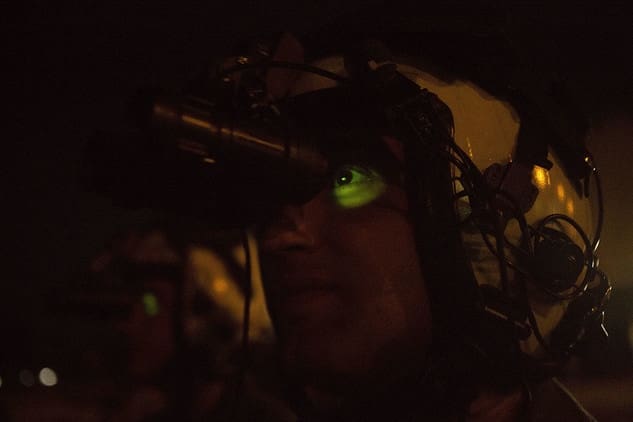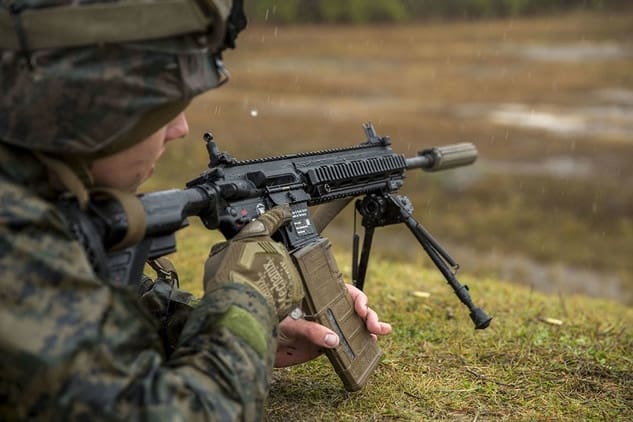MARINE CORPS BASE QUANTICO, Va. —
Marine Corps Systems Command’s Program Manager for Infantry Weapons has begun a large-scale modernization project to increase the lethality of the infantry squad.

PM IW strives to equip and sustain the Marine Corps with fully-integrated infantry weapons, optics and nonlethal systems for the Ground Combat Element.
The portfolio’s modernization efforts adhere to Commandant of the Marine Corps Gen. David Berger’s vision to redesign the force to meet the challenges of a new age of great power competition. Through PM IW, the Corps plans to field numerous new weapon and optic systems over the next decade.
“This is the largest modernization of the infantry squad in the last 25 years,” said Lt. Col. Tim Hough, MCSC’s program manager for Infantry Weapons.
Strengthening systems
PM IW has begun the procurement of the Modular Handgun System, which will replace all Marine Corps pistols. This striker-fired pistol includes a plastic clip-on piece, enabling Marines to change grip sizes to accommodate different hand sizes. The weapon is compatible with the pistol-aiming module used by some units.
MCSC will begin fielding the system this fiscal year.
“The MHS improves on the precision and reliability of the legacy platforms, while also bringing with it new, more effective ammunition,” said Maj. Mike Brisker, weapons product manager for PM IW.

MCSC is expanding the use of the M27 Infantry Automatic Rifle. Originally fielded to infantry units as a replacement for the M249 Squad Automatic Weapon in 2011, the rifle received overwhelmingly positive feedback from Marines. This feedback led to the Marine Corps’ decision to field the M27 to all rifle platoons as their primary individual weapon.
“We expect fielding of [the M27] to conclude by the end of this fiscal year,” said Brisker.
PM IW is also enhancing its optic systems. Fielded in spring 2020, the Squad Binocular Night Vision Goggle is a helmet-mounted system that offers improved depth perception, and the ability to detect and recognize targets in extreme low light, in inclement weather and in the presence of obscurants. The SBNVG provides additional capabilities that the legacy system, the AN/PVS-14, lacked.
Since awarding a contract in February 2020, PM IW plans to begin fielding the Squad Common Optic in fiscal year 2021. The SCO includes a magnified day optic, which improves situational awareness, decreases engagement times and increases probability of hit.
“The Squad Common Optic enables Marines to see farther and identify the enemy more quickly,” said Hough.
MCSC is collaborating with other services to field certain systems. For example, the Marine Corps will partner with the Army to procure the Next-Generation Squad Weapon system, intended to replace the M27 and become the primary individual weapon for infantry units.
The NGSW will provide a significant boost to the lethality of the individual soldier and Marine. The weapon includes an optic/fire control system that will incorporate a disturbed reticle to improve the shooter’s accuracy.
The Marine Corps could receive first deliveries of the NGSW as early as fiscal year 2025, said Brisker.
Additionally, PM IW and Fleet Marines are participating in the Army’s Integrated Visual Augmentation System and the Enhanced Night Vision-Binocular programs to help inform requirements and programmatic decisions in the future.
Enhancing performance
PM IW’s modernization efforts mirror MCSC’s mission to increase lethality among Marines. The command is continuously striving to equip Marines with the capabilities needed to successfully fulfill missions. To meet this goal, PM IW will continue to solicit feedback from Marines and industry.
“In line with the Commandant’s Planning Guidance, we’re looking to lighten the load and increase the overall lethality of Close Combat Forces—specifically infantry Marines,” said CW4 David Tomlinson, an infantry weapons officer with PM IW.
Tomlinson believes upgrading Infantry Weapon systems will ultimately enhance performance on the battlefield and increase survivability at a time when enemies are strengthening.
“These efforts show we are focused on staying abreast of advancements that are coming quickly,” said Tomlinson. “It also shows our desire to stay persistent, look toward the future, and make sure our Marines receive the best [systems] we can buy.”
Story by Matt Gonzales, MCSC Office of Public Affairs and Communication | Marine Corps Systems Command
Photos by LCpl Michaela R. Gregory and Kealii De Los Santos


The USMC ended up saying no to the ENVG-B(I was a part of the program/testing). That being said, they may buy more but currently we have no plans to. Current issue helmets have a lip that isn’t compatible with the ENVG-B mounts.
A new helmet program for Infantry is getting ready to launch. Of course, they’re axing an entire Regiment at the same time.
Way to go Marine Corps, fielding a new service weapon without going through a proper competition and selecting an outdated non-US rifle to boot.
As opposed to the Socom’s adding a new rail to a 60 year old rifle. Or the Army’s pipe dream of a case-less rifle. How dare the Marine Corps take a proven rifle that’s been designed in this century.
The Marines adopted a rifle that performs worse than the M4A1. Not exactly a great idea. There were better ways to get a freefloated heavy barrel rifle.
^^^^^Seans is right. And the SOCOM profile M4A1 barrel is a freaking laser beam with a pretty proven gas block.
And a lot lighter!
M4a1 out preforms the 416!! What a joke
Officials tested 10 each of the four carbine models, firing a total of 60,000 rounds per model. Here’s how they ranked, according to the total number of times each model stopped firing:
• XM8: 127 stoppages.
• MK16 SCAR Light: 226 stoppages.
• 416: 233 stoppages.
• M4: 882 stoppages.
By your account, the SCAR L beat the 416. As an owner of multiple clones and a SCAR16, the 16 blows goat balls compared to a Block II with SOCOM barrel in regards to accuracy and prolonged fire schedule. That’s with NATO ball, M855 and Mk262. But YMMV.
The SCAR L had more stoppages.. reading is hard. The 416 is a far superior rifle than the M4a1 in every way.
Ummm, typing isn’t your strong point. You list the SCAR has having 226 stoppages and the 416 as 233. That’s a difference of 7. So either your math or typing sucks. Superior is judged by many things….is it more superior in weight? Judging it against a stock M4 is kinda ghey in that we are now into M4A1 with a better barrel, free floated, etc. Your HK is inferior in regards to weight. M4’s have won more hearts and minds than the 416 as well. So it’s inferior in them numbers too. Is it superior in cost effectiveness to issue in large scale? Inferior too. Enough Marines have commented to concede the IAR is a pig, hate humping it but love the fact they have a newer weapon. And comparing new kit to shit that’s been beat and used like a barefoot wife in the Bible Belt is a no brainer in what’s a winner. Joes aren’t very different from squirrels in regards to objects that shine bright with no real value over their current nut.
FYI that study was horribly flawed.
The M4 was fed with shitty used usgi mags.
The HK, SCAR, & XM8 had new undamged magazines provided by the mfgrs.
That test was greatly flawed in that the M4 had well worn used magazines and the XM8, SCAR & hk416 used brand new magazines supplied from the mfgr.
Desperately need new helmets. The ECH or whatever was so unfortable Marines didn’t even want to buckle the chin strap
HK416 is an overweight, expensive pig with proprietary supply chain.. so dumb.
A PIP M4A1 upper with heavier barrel, midlength gas system, and freefloat rail would have answered that mail.
Instead of a new silly HK carbine.. Imagine if they:
1- put a 1-6/10x optic on a SOCOM URGI equivalent.
2- Issued small individual range finders, had squad leaders call direction & distance
3- placed a video game in the barracks that taught them how to use a Christmas tree reticle.
1. Tried that. The optic was shot down at first, was deemed ‘unfair’ to compare against the M27 + SDO combination. The rifle tech demonstrator was attempted as well (14.5″ mid gas CHF, rifle length FF MLOK RAS, few other doo dads) but was shot down on the basis of the test article bolts prematurely failing in durability testing. Also the PMIW at the time adamantly opposed (lazy) doing the work to adopt the 75th RR program with the Block II upgrades.
“the rifle received overwhelmingly positive feedback from Marines.”
What Marines did they talk to? Because every one I’ve met that had hands-on with the M27 has said that it was too heavy/bulky for what it is and that they’d rather have an M4A1 with a modern hand guard.